ASUS HD 6950 DirectCU II review index
- Page 1 – HD6950 DC2: Presentation
- Page 2 – HD6950 DC2: Features
- Page 3 – HD6950 DC2: OpenGL Tests
- Page 4 – HD6950 DC2: Direct3D Tests
- Page 5 – HD6950 DC2: Gaming Tests
- Page 6 – HD6950 DC2: Power Consumption and Overclocking
- Page 7 – HD6950 DC2: Conclusion
3 – ASUS HD 6950 DirectCU II OpenGL Tests
Testbed:
– CPU: Core i7 960 @ 3.2GHz
– RAM: 4GB DDR3 Corsair Dominator
– Motherboard: GIGABYTE X58-A UD5
– Windows 7 64-bit
– Graphics drivers: Catalyst 11.1a hotfix Jan26
– PSU: Corsair AX1200
3.1 FurMark (OpenGL 2)
FurMark 1.8.2 has been used for the test. FurMark homepage is HERE.
Settings: 1920×1080 fullscreen, no AA, no postFX, 60sec, Xtreme mode UNCHECKED.
Rule: The higher the number of points, the faster the card is.
| 8362 points (140 FPS) – EVGA GeForce GTX 580 SC, ***OCP disabled***, GPU core: 880MHz |
| 8259 points (138 FPS) – ASUS ENGTX580 ***OCP disabled***, GPU Core: 871MHz, VDDC: 1.088V |
| 7769 points (130 FPS) – EVGA GeForce GTX 580 SC, ***OCP disabled***, GPU core: 797MHz |
| 6470 points – EVGA GeForce GTX 480 |
| 6341 points (FPS: 106) – SAPPHIRE Radeon HD 6970, GPU core: 880MHz, PowerTune: +20% |
| 5841 points (97 FPS) – ASUS GeForce GTX 560 Ti DirectCU II TOP |
| 5742 points (96 FPS) – ASUS Radeon HD 6950 DC2 (GPU @ 810MHz), PowerTune: +20% |
| 5420 points – ATI Radeon HD 5870 |
| 5383 points – ASUS Radeon HD 6950, PowerTune: +20% |
| 5161 points – MSI GeForce GTX 470 |
| 4641 points (FPS: 78) – SAPPHIRE Radeon HD 6870, GPU core: 1000MHz |
| 4583 points (FPS: 76) – SAPPHIRE Radeon HD 6870, GPU core: 980MHz |
| 4484 points (FPS: 74) – ASUS EAH6870 |
| 4310 points (FPS: 72) – SAPPHIRE Radeon HD 6870 |
| 4243 points (FPS: 71) – EVGA GeForce GTX 580 SC, OCP enabled |
| 3912 points (FPS: 65) – SAPPHIRE Radeon HD 6970, GPU core: 880MHz, PowerTune: 0 |
| 3884 points – MSI N460GTX Cyclone 768D5 OC |
| 3824 points (FPS: 64) – SAPPHIRE Radeon HD 6970, GPU core: 880MHz, PowerTune: -20% |
| 2772 points – MSI R5770 Hawk |
3.2 TessMark (OpenGL 4)
Hardware tessellation is one of the big features of Direct3D 11 and OpenGL 4 capable graphics cards. TessMark is a new benchmark focused only on the tessellation engine of DX11 class cards. It’s a pure tessellation benchmark, it does not contain complex shader or other heavy texture fetches. TessMark shows an overview of the tessellation engine raw power, that’s all. DX11 specifies that the tessellation factor can vary from 1.0 up tp 64.0. Of course, for tessellation factors like 32 or 64, most of the tessellated triangles are smaller than… a pixel. In those cases, tessellation is useless and in a real world application such as a game, high tessellation factors won’t be used. But in the case of a synthetic benchmark, it’s always instructive to see how cards can handle the whole range of tessellation level.
TessMark 0.2.2 has been used for the test.
Settings: 1920×1080 fullscreen, no AA, 60sec, map set 1.
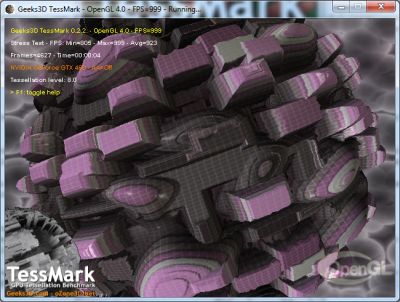
Rule: The higher the number of points, the faster the card is.
Tessellation factor 8.0: moderate
| 53151 (888FPS) – EVGA GTX 580 SC |
| 52188 (872FPS) – ASUS ENGTX580 |
| 48084 – EVGA GeForce GTX 480 |
| 39663 points (662 FPS) – ASUS GeForce GTX 560 Ti DirectCU II TOP |
| 38191 – MSI GeForce GTX 470 |
| 30512 – MSI N460GTX Cyclone 768D5 OC |
| 29633 points (494 FPS) – ASUS Radeon HD 6950 DC2 (GPU @ 810MHz) |
| 27718 (462FPS) – Sapphire HD 6870, GPU core: 1000MHz |
| 27469 (458FPS) – Sapphire HD 6970, GPU core: 880MHz |
| 26223 – ASUS EAH6870 |
| 25480 (425FPS) – ASUS Radeon HD 6950 |
| 24161 (403FPS) – ATI Radeon HD 5870 |
| 23131 (386FPS) – Sapphire HD 6870 |
| 20745 – MSI R5770 Hawk |
Tessellation factor 16.0: normal
| 33266 (555FPS) – EVGA GTX 580 SC |
| 32666 (545FPS) – ASUS ENGTX580 |
| 29196 – EVGA GeForce GTX 480 |
| 23594 points (393 FPS) – ASUS GeForce GTX 560 Ti DirectCU II TOP |
| 23316 – MSI GeForce GTX 470 |
| 17452 – MSI N460GTX Cyclone 768D5 OC |
| 9255 (154FPS) – Sapphire HD 6870, GPU core: 1000MHz |
| 8846 points (147 FPS) – ASUS Radeon HD 6950 DC2 (GPU @ 810MHz) |
| 8555 – ASUS EAH6870 |
| 8229 (137FPS) – Sapphire HD 6970, GPU core: 880MHz |
| 8177 (136FPS) – Sapphire HD 6870 |
| 8018 (134FPS) – ATI Radeon HD 5870 |
| 7669 – MSI R5770 Hawk |
| 7384 (123FPS) – ASUS HD 6950 |
Tessellation factor 32.0: extreme
| 15427 (257FPS) – EVGA GTX 580 SC |
| 15128 (252FPS) – ASUS ENGTX580 |
| 13008 – EVGA GeForce GTX 480 |
| 9997 – MSI GeForce GTX 470 |
| 9878 points (165 FPS) – ASUS GeForce GTX 560 Ti DirectCU II TOP |
| 6729 – MSI N460GTX Cyclone 768D5 OC |
| 2299 – ASUS EAH6870 |
| 2246 (38FPS) – Sapphire HD 6870 |
| 2156 (36FPS) – ATI Radeon HD 5870 |
| 2122 (35FPS) – Sapphire HD 6970, GPU core: 880MHz |
| 2159 – MSI R5770 Hawk |
| 1988 points (33 FPS) – ASUS Radeon HD 6950 DC2 (GPU @ 810MHz) |
| 1910 (32FPS) – ASUS HD 6950 |
Tessellation factor 64.0: insane
| 4940 (82FPS) – EVGA GTX 580 SC |
| 4840 (81FPS) – ASUS ENGTX580 |
| 3963 – EVGA GeForce GTX 480 |
| 3169 – MSI GeForce GTX 470 |
| 2895 points (48 FPS) – ASUS GeForce GTX 560 Ti DirectCU II TOP |
| 1959 – MSI N460GTX Cyclone 768D5 OC |
| 585 – ASUS EAH6870 |
| 574 (10FPS) – Sapphire HD 6870 |
| 565 – MSI R5770 Hawk |
| 550 (10FPS) – ATI Radeon HD 5870 |
| 539 (9FPS) – Sapphire HD 6970, GPU core: 880MHz |
| 490 points (9 FPS) – ASUS Radeon HD 6950 DC2 (GPU @ 810MHz) |
| 485 (9FPS) – ASUS HD 6950 |
Remark: high tessellation factors are very hard with the HD 6950: with current driver, the HD 6950 is slower than a HD 6870 or a Radeon HD 5770 (MSI Hawk).
3.3 ShaderToyMark (OpenGL 2)
ShaderToyMark 0.1.0 is an OpenGL 2 benchmark, developed with GeeXLab,
and focused on pixel shaders only. The pixel shaders are heavily based on math (few texture fetches) and then ShaderToyMark can be seen as a kind of GPU computing benchmark.
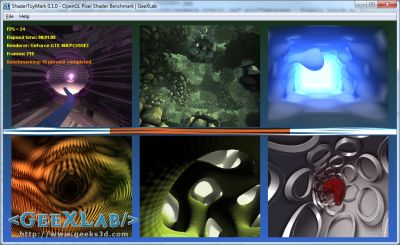
Settings: 960×540 windowed, no AA, 60sec
| 316 points (52 FPS) – EVGA GTX 580 SC |
| 306 points (51 FPS) – ASUS ENGTX580 |
| 263 points (43 FPS) – GeForce GTX 480 |
| 242 points (40 FPS) – ASUS Radeon HD 6950 DC2 (GPU @ 950MHz) |
| 234 (39FPS) – Sapphire HD 6970 |
| 218 points (36 FPS) – ASUS GeForce GTX 560 Ti DirectCU II TOP |
| 208 (34FPS) – ASUS HD 6950 |
| 207 points (34 FPS) – ASUS Radeon HD 6950 DC2 (GPU @ 810MHz) |
| 189 points (31 FPS) – ATI Radeon HD 5870 |
| 184 points (30 FPS) – ASUS EAH6870 |
| 179 (29FPS) – Sapphire HD 6870 |
| 156 points (26 FPS) – MSI N460GTX Cyclone |
| 104 points (17 FPS) – MSI R5770 Hawk |
| 46 points (7 FPS) – GeForce 9800 GTX |
| 36 points (6 FPS) – EVGA GTX 280 |
| 33 points (5 FPS) – GeForce GTX 260 |
Remark: with a nice overclocking (GPU: 950MHz), the HD 6950 DC2 is faster (242 points) than a Radeon HD 6970 (234 points).
3.4 OpenGL 4 Mountains demo
Mountains demo is an OpenGL 4 demo that shows hierarchical-Z map based occlusion culling in action.
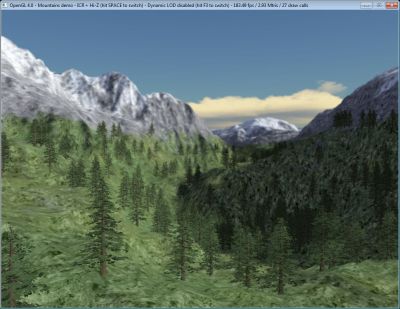
Settings: default window size: 1024×768, ICR enabled (Instance Cloud Reduction), Hi-Z enabled and dynamic LOD enabled.
| 684 FPS – EVGA GTX 580 SC |
| 674 FPS – ASUS ENGTX580 |
| 568 FPS – EVGA GTX 480 |
| 492 FPS – ASUS GeForce GTX 560 Ti DirectCU II TOP |
| 390 FPS – Sapphire Radeon HD 6970 |
| 360 FPS – ASUS Radeon HD 6950 DC2 (GPU @ 810MHz) |
| 350 FPS – MSI N460GTX Cyclone 768D5 |
| 318 FPS – ASUS Radeon HD 6950 |
| 255 FPS – ASUS EAH6870 |
| 235 FPS – Sapphire Radeon HD 6870 |
| 231 FPS – Radeon HD 5870 |
| 220 FPS – MSI R5770 Hawk |
3.5 GluxMark2 (OpenGL 2)
GluxMark2 is a purely syntethic OpenGL benchmark
and tries to measure performance from every point of view by using programmable graphics pipeline (vertex, geometry and fragment/pixel shaders).

No GluxMark2 score available for ASUS HD 6950 DC2 – test failure.
Certainly due to an issue with Catalyst 11.1a hotfix.
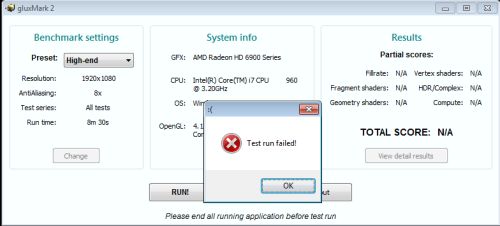
Here are the scores for other cards including ASUS HD 6950 (regular edition), which has the same performance then HD 6950 DC2:
Preset: high-end (1920×1080, MSAA: 8X)
| 11002 points (OpenCL: +4318 = 15320 points) – EVGA GTX 580 SC |
| 9216 points (OpenCL: +2776 = 11992 points) – GeForce GTX 480 |
| 8099 points – Radeon HD 5870 |
| 8026 points (OpenCL: +654 = 8680 points) – ASUS Radeon HD 6950 |
| 8010 points (OpenCL: +709 = 8719 points) – Sapphire Radeon HD 6970 |
| 7873 points (OpenCL: +4257 = 12130 points) – ASUS GeForce GTX 560 Ti DirectCU II TOP |
| 6615 points – Sapphire Radeon HD 6870 |
| 5367 points (OpenCL: +2789 = 8156 points) – MSI N460GTX Cyclone |
3.6 Unigine Heaven (OpenGL 4)
For this last OpenGL test, I used Ungine Heaven 2.1, one of the standard Direct3D / OpenGL synthetic benchmark.
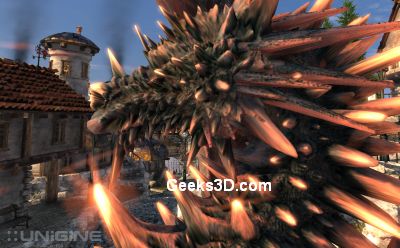
Settings: 1920×1080 fullscreen, OpenGL rendering, tessellation: normal, shaders: high, AA: 4X, 16X anisotropic filtering.
| 48.6 FPS, Scores: 1224 – EVGA GTX 580 SC |
| 46.4 FPS, Scores: 1168 – ASUS ENGTX580 |
| 38.7 FPS, Scores: 974 – EVGA GeForce GTX 480 |
| 35.8 FPS, Scores: 901 – ASUS GeForce GTX 560 Ti DirectCU II TOP |
| 24.7 FPS, Scores: 622 – SAPPHIRE Radeon HD 6970 |
| 24.5 FPS, Scores: 617 – MSI N460GTX Cyclone 768D5 OC |
| 24.2 FPS, Scores: 609 – ASUS Radeon HD 6950 DC2 |
| 21.6 FPS, Scores: 544 – ASUS Radeon HD 6950 |
| 15.9 FPS, Scores: 400 – ATI Radeon HD 5870 |
| 13.6 FPS, Scores: 342 – ASUS EAH6870 |
| 13.5 FPS, Scores: 339 – SAPPHIRE HD6870 |
| 9 FPS, Scores: 227 – MSI R5770 Hawk |
Remark: like for TessMark in moderate and normal tessellation levels, the HD 6950 DC2 is faster than a Radeon HD 6950 reference board. The reason of this increase of speed are the optimizations done by AMD OpenGL driver team in Catalyst 11.1a hotfix Jan26. More details here: Catalyst 11.1a Hotfix (Jan26): Gains up to 18% in OpenGL Tessellation.
ASUS HD 6950 DirectCU II review index
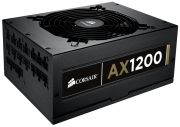
Pingback: ASUS GeForce GTX 580 DirectCU II Overclocked at 1519MHz!!! - 3D Tech News, Pixel Hacking, Data Visualization and 3D Programming - Geeks3D.com
Great stuff.
How about overclocking it with MSI Afterburner with unofficial overclocking enabled? Could it go past 950Mhz?
I’ll try to post a short article on that topic but with “unofficial overclocking enabled”, I managed to reach 1030MHz under 3DMark11. Under FurMark, 950MHz seems to be the max stable clock speed, no matter the GPU voltage.
Could you please check and see if that is a real BIOS switch? From what I understood from a picture on the product page, it’s for something else.
http://www.asus.com/product.aspx?P_ID=mMAaEwb08yxZPzVe
@Em: yep you’re right, I didn’t see the picture and indeed the switch seems to be for display outputs instead of dual-BIOS. I will check with ASUS asap.
Any news regarding the switch?
Just sent an email right now! As soon as I get the answer, I update the article.
Has anybody bios from ASUS 6970 DirectCU II ?? please?
Still no news on the switch?
Could it be that Asus support rarely answers?
Asked them a few things about this card also and after nearly 3 weeks i still dont have a answer.
Meh.
Ooops, I received the answer some days ago: according to ASUS, it’s a switch related to DVI linking, nothing to do with dual-BIOS.
asus are fucking fuckers with that switch!!!!! wrrrr…it coulde be one of te best cards! omg 🙁
I have this card installed but for some reason when i open cpuz it doesnt show my clock speed or memory speed but it says I have -2048mb video memory…wtf.
I bought this card because the review said the switch is a “DUAL BIOS SWITCH”. Now I find out THAT IT IS NOT. Thanks a lot buddy. You might wanna fix this review.
By the way I just flashed(attempted) my Asus hd 6950 dc2 but it gave me a Blue screen hard crash……I only attempted to use winflash and ati rbe to just change the shaders to unlock 6970 status…FAILED…Stupidly I didnt have a flash drive so all i did was switch the little switch and IM fine…still normal bios though…But i havnt tried switching it back to the other one so I couldnt tell you if that worked…but as of now It is a dual bios switch.
Ok i just found some outstanding results with this card people….everyone i just flashed it to a 6970 I have compiled a bios file if anyone would like a walkthru i will be glad to help them….This is now the best ati card (except 6990) right now….overclocked to 950 core 1350 mem and it is 1536 unified shaders 91.2GTexel/s I am extremly happy now….MY email is DerMoor@hotmail.com please no spam.
Yeah I got mine clocked at 950/1350 as well. That silly BIOS trick isn’t worth possibly bricking my card. All the reviews show the unlock gains only 5% performance, whereas OC’ing gives the REAL gains. I do in fact love this card.
Yea it is risky…but I still got the overclock and also higher shaders….Its not much of a gain between 5-20+ fps depends on the game and/or the benchmark utility. I use heaven dx11 demo cuz its pretty nice…also msi kombust or 3d mark vantage 1.1(free i think) idk….I am very pleased with this card to begin with but its pretty nice to prove people wrong about things…This card is a very nice tool for extreme gaming….once again thank you asus for a beast…cant wait until u make a 6990 dcii (with a modded bios switch) im all over it.
Who are you proving wrong? The switch on this card is not a BIOS switch. On reference cards the switch toggles between a read-only BIOS and a writeable BIOS. This card has only 1 BIOS (writable). If you hose that BIOS the card is bricked.
I’m talkin about the people that say this card isn’t unlockable and I tell u one thing if I turn my card on and let it load up I open gpuz it says I have 1536 unified shaders. Then if I turn my CPU off move the switch to the right and load it it does not. Maybe I have a reference board idk but I crashed my first bios loaded the second switch on and I was fine and was able to reflash my gpu again….then I could use the first switch again so I tried a different approach and it worked but if I flip the switch the other one is different. 1408 shaders….but IDC Im sorry for saying anything u win kid
The card has both BIOS chips present… to verify, at the right of the South-Eastern GPU screw on the back of the card with the PCIe slot down, there is a horizontally placed/soldered chip… that’s the 2nd BIOS not present on cards without the switch.
So the article is right but might have been by mistake, and ASUS kept quiet for commercial reasons, but you might hear about it if you bump into the support team when and if needed.
Thank you em…He is correct Asus keeps things underwraps…Hell if everyone knew this there could be problems with Asus stealing everybodies business lol THANK YOU ASUS what a badass card..ROAR
I have been working on unlocking this card with Derrick today and after numerous bad bios attempts (I got a little too agressive on bios edits) and resets I can say without a doubt that the switch is for the DUAL BIOS as both Derrick and Em suggested. So far I have had the best luck backing up the original bios and then using the Radeon Bios Editor to unlock the shaders. I am showing 1536 shaders in GPU-Z and after some overclocking this thing is smoking fast!
Pingback: Cercasi informazioni Asus Radeon HD6950 DirectCU II - Forum di Tom's Hardware
Well today Garth had another breakthru and finally proved the fact that we can flash this card to a ASUS hd 6970 dcuii with the increased stock voltage to 1.175 which has allowed me to clock my card to 1015/1425. Have only ran haven dx11 benchmark which showed very little artifacts with a little tweaking I’m sure this can be resolved overall the flash was a success and everything looks ok. Temps didn’t really increase from what I can see…crossing fingers that the VRAM can keep up.
Can 2 ASUS HD 6950 DirectCU II (Crossfire) be installed on P8P67 Deluxe? Or will the 3-slot height VGA cooler be a problem?
Well I am back I finally received my NEW hd 6950 dcuii RMA lol….I got very aggressive with this card and flashed from the 6970 bios garth gave me to a voltage modified 6950 bios which ended up bricking my card….Sadly before I figured out how to fix this card by pci flashing I RMA it cuz both bios switches were messed up because of the bad flash lol….WEll Asus Is spectacular with their customer service and made everything alllll better with a brand new in box Hd 6950 DCUII. So I am going to hold off on flashing with 6970 and see how I perform stock for a while…Hell I am even too scared now to even overclock higher than the stock 810 right now. Anyone have this card at 950/1350 nonunlocked runnin at this speed for a while. And if so is there any signs of wear and tear. thanks.
Hey guys,
I have the HD6950 DCU II 2GB. I’ve tried quite a few methods in order to unlock the shaders – so far havent had any luck.
How have you guys unlocked your cards? I’ve tried enabling the shaders using RBE and then Winflashing. Also tried to flash with the HD6970 DCU II. GPUz still reports 1408 shaders.
Any help would be much appreciated.
Cheers,
Marc.
I’ve clocked mine HD5830 up to 980/5000MHz/1.125V
Awesome card for clockers with knowledge 🙂
Well I am still receiving emails regarding unlocking this card….as stated above I did unlock it but also eventually ruined my card. I RMA it to asus and luckily they replaced and shipped a new one for free…I noticed right off the back as soon as I installed this new card it performed better than my original card did at its stock state. So I figured why not try it again. Well I have tried every method I was able to do before and am completely unsucessful. I think I as well as a few others were lucky enough to buy cherry picked dcII cards. I wish i could be 100 percent certain but I couldnt use the bios garth and I compiled because I had to do a fresh install of windows and had no recovery available. So I really think the best way to get your money outta this card is to OVERCLOCK ONLY….I now use smartdoctor to control my voltage since afterburner does not allow this card to change volts..1.175 and then I OC’ed to 900/1300 because for some reason anything higher and it crashes but I dont think its a heat thing but who knows.
Can i crossfire the asus 2gb 6950 direct cu2 with the first generation asus 2gb 6950 on a 750w psu……no overclocks…just standard settings?
Not sure if it has been mentioned but this article has a few errors. That is not a dual bios switch, it’s a dual lane DVI switch which assigns some bandwidth from one of the HDMIs to DVI so you can run beyond 1920 x 1200 on that port (which leaves hdmi1 disabled).
This card has no dual bios switch so reflash at your peril!
to unlock the bios on this card – u need to use RBE.
Download ur original bios through RBA, go to the furthest tab to the right and click the unlock shaders / 6970 shaders option.
DO NOT change anything else or you will blue screen on reboot.
Using a premodified reference bios to flash this card doesnt work.
Hope this helps,
PES
I HAVE THIS CARD THE ASUS HD6950 DIRECTCU11 THE SWITCH IS INDEED DUAL BIOS , I HAVE THE 1 POSITION SET WITH THE SHADERS UNLOCKED AND I LEFT 2 POSITION UNFLASHED AS STANDARD JUST INCASE I EVER GET A BAD FLASH ON POSITION 1 JUST WANTED TO SET THE RECORD STRAIGHT IT IS A DUAL BIOS SWITCH